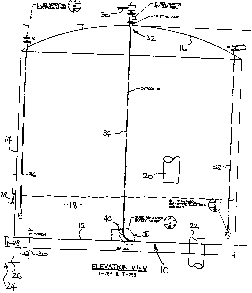Some of the information on this Web page has been provided by external sources. The Government of Canada is not responsible for the accuracy, reliability or currency of the information supplied by external sources. Users wishing to rely upon this information should consult directly with the source of the information. Content provided by external sources is not subject to official languages, privacy and accessibility requirements.
Any discrepancies in the text and image of the Claims and Abstract are due to differing posting times. Text of the Claims and Abstract are posted:
| (12) Patent: | (11) CA 2141127 |
|---|---|
| (54) English Title: | CORROSION PROTECTION SYSTEM |
| (54) French Title: | SYSTEME DE PROTECTION CONTRE LA CORROSION |
| Status: | Term Expired - Post Grant Beyond Limit |
| (51) International Patent Classification (IPC): |
|
|---|---|
| (72) Inventors : |
|
| (73) Owners : |
|
| (71) Applicants : |
|
| (74) Agent: | MARKS & CLERK |
| (74) Associate agent: | |
| (45) Issued: | 2004-08-17 |
| (22) Filed Date: | 1995-01-26 |
| (41) Open to Public Inspection: | 1996-07-27 |
| Examination requested: | 2000-06-20 |
| Availability of licence: | N/A |
| Dedicated to the Public: | N/A |
| (25) Language of filing: | English |
| Patent Cooperation Treaty (PCT): | No |
|---|
| (30) Application Priority Data: | None |
|---|
An electrolyte protection system has a strap extending from an electrode to the base of the vessel. The strap is non-conductive and porous to carry electrolyte into contact with the electrode. A secondary current path is thus established to inhibit electrical discharge from the electrode.
Un système de protection électrolytique a une sangle qui s'étend entre une électrode et la base du navire. La sangle est non conductrice et poreuse pour mettre l'électrolyte en contact avec l'électrode. Un trajet de courant secondaire est ainsi établi pour inhiber une décharge électrique de l'électrode.
Note: Claims are shown in the official language in which they were submitted.
Note: Descriptions are shown in the official language in which they were submitted.

2024-08-01:As part of the Next Generation Patents (NGP) transition, the Canadian Patents Database (CPD) now contains a more detailed Event History, which replicates the Event Log of our new back-office solution.
Please note that "Inactive:" events refers to events no longer in use in our new back-office solution.
For a clearer understanding of the status of the application/patent presented on this page, the site Disclaimer , as well as the definitions for Patent , Event History , Maintenance Fee and Payment History should be consulted.
| Description | Date |
|---|---|
| Inactive: Expired (new Act pat) | 2015-01-26 |
| Small Entity Declaration Request Received | 2007-12-12 |
| Small Entity Declaration Determined Compliant | 2007-12-12 |
| Grant by Issuance | 2004-08-17 |
| Inactive: Cover page published | 2004-08-16 |
| Inactive: Final fee received | 2004-06-01 |
| Pre-grant | 2004-06-01 |
| Notice of Allowance is Issued | 2003-12-01 |
| Letter Sent | 2003-12-01 |
| Notice of Allowance is Issued | 2003-12-01 |
| Inactive: Approved for allowance (AFA) | 2003-11-19 |
| Amendment Received - Voluntary Amendment | 2003-09-25 |
| Inactive: S.30(2) Rules - Examiner requisition | 2003-04-02 |
| Letter Sent | 2002-05-29 |
| Reinstatement Requirements Deemed Compliant for All Abandonment Reasons | 2002-05-16 |
| Deemed Abandoned - Failure to Respond to Maintenance Fee Notice | 2002-01-28 |
| Letter Sent | 2001-03-13 |
| Reinstatement Requirements Deemed Compliant for All Abandonment Reasons | 2001-03-05 |
| Deemed Abandoned - Failure to Respond to Maintenance Fee Notice | 2001-01-26 |
| Letter Sent | 2000-07-13 |
| Inactive: Status info is complete as of Log entry date | 2000-07-13 |
| Inactive: Application prosecuted on TS as of Log entry date | 2000-07-13 |
| Letter Sent | 2000-06-29 |
| Reinstatement Requirements Deemed Compliant for All Abandonment Reasons | 2000-06-20 |
| Request for Examination Requirements Determined Compliant | 2000-06-20 |
| All Requirements for Examination Determined Compliant | 2000-06-20 |
| Deemed Abandoned - Failure to Respond to Maintenance Fee Notice | 2000-01-26 |
| Letter Sent | 1999-03-16 |
| Reinstatement Requirements Deemed Compliant for All Abandonment Reasons | 1999-03-04 |
| Deemed Abandoned - Failure to Respond to Maintenance Fee Notice | 1999-01-26 |
| Application Published (Open to Public Inspection) | 1996-07-27 |
| Abandonment Date | Reason | Reinstatement Date |
|---|---|---|
| 2002-01-28 | ||
| 2001-01-26 | ||
| 2000-01-26 | ||
| 1999-01-26 |
The last payment was received on 2004-01-23
Note : If the full payment has not been received on or before the date indicated, a further fee may be required which may be one of the following
Patent fees are adjusted on the 1st of January every year. The amounts above are the current amounts if received by December 31 of the current year.
Please refer to the CIPO
Patent Fees
web page to see all current fee amounts.
Note: Records showing the ownership history in alphabetical order.
| Current Owners on Record |
|---|
| CORROSION SERVICE COMPANY LIMITED |
| Past Owners on Record |
|---|
| WINSTON SHIM |